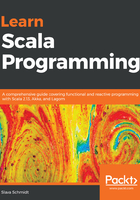
上QQ阅读APP看书,第一时间看更新
Conventions used
There are a number of text conventions used throughout this book.
CodeInText: Indicates code words in text, database table names, folder names, filenames, file extensions, pathnames, dummy URLs, user input, and Twitter handles. Here is an example: "In Scala 2.13, StringOps has been extended with option-returning methods for string literals parsing. Supported types include all numeric types and Boolean."
A block of code is set as follows:
object UserDb {
def getById(id: Long): User = ???
def update(u: User): User = ???
def save(u: User): Boolean = ???
}
When we wish to draw your attention to a particular part of a code block, the relevant lines or items are set in bold:
scala> val user = User("John", "Doe", "jd@mail.me")
user: User = User(John,Doe,jd@mail.me)
scala> naiveToJsonString(user)
res1: String = { "name": "John", "surname": "Doe", "email": "jd@mail.me" }
Any command-line input or output is written as follows:
take
-S--c--a--l--a-- --2--.--1--3-
take
Lazy view constructed: -S-S-c-C-a-A-l-L-a-A- -
Lazy view forced: -S--c--a--l--a-- -List(S, C, A, L, A, )
Strict: List(S, C, A, L, A, )
Bold: Indicates a new term, an important word, or words that you see on screen.
Warnings or important notes appear like this.
Tips and tricks appear like this.